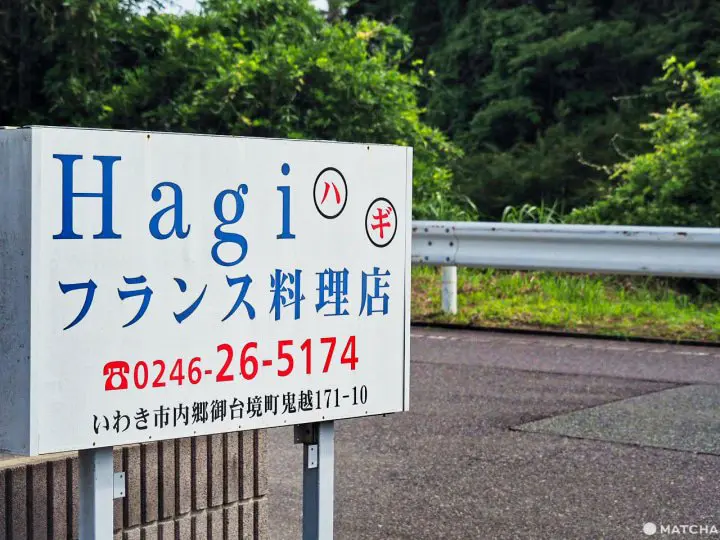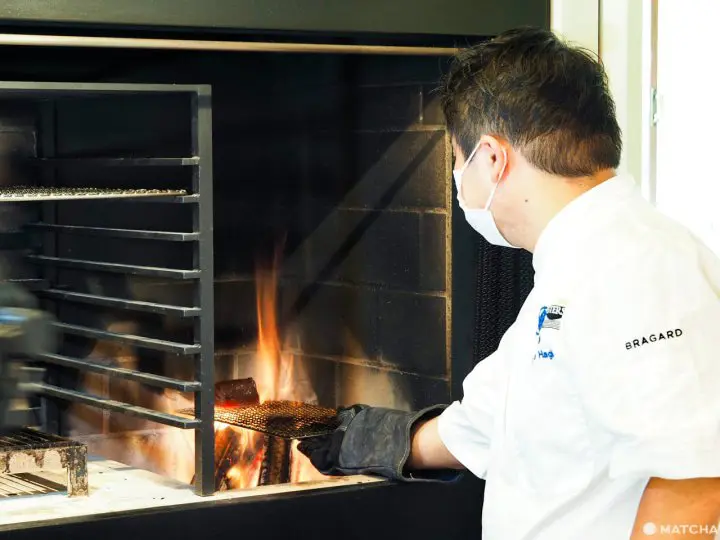Hagi French Restaurant: Collaborating with Farmers in Fukushima

Gourmets and foodies from Japan and abroad flock to Fukushima's Hagi French Restaurant. It serves tasty cuisine using fresh ingredients made with the motto "local food production and consumption." In this article, we asked chef Hagi about his thoughts on Fukushima ingredients.
Hagi French Restaurant: Showcasing the Appeal of Local Ingredients
In Fukushima Prefecture, there is a restaurant visited by gourmets and foodies from far and wide. It's called Hagi French Restaurant.
The restaurant opened in 1998. After experiencing the Great Tohoku Earthquake in 2011, owner-chef Harutomo Hagi joined forces with local farmers to spread the word about Fukushima's ingredients.
"It's by understanding the growers that the true flavor of the ingredients can be shown," he said. Even now, ten years after the earthquake, the chef's love for his hometown and thoughts about his cuisine haven't changed.
In this interview, we asked him why he became a chef and his thoughts on Fukushima ingredients.
Why Mr. Hagi Decided to Become a Chef

Photo taken at Hagi French Restaurant
"Thanks to my grandmother, our family's kitchen table was always blessed with vegetables that she lovingly grew on her farm. I remember being amazed by how delicious they tasted," Mr. Hagi recounted.
Smiling, he added, "I decided to become a chef because I wanted many people to know the special appeal of food."
Chef Hagi attended a famous cooking school called the Tsuji Culinary Institute. He studied French cooking there before heading off to France for more training. While overseas, Hagi became even more impressed by the depth and scope of French food.
After completing his training, he considered opening a restaurant in Fukushima. Here, French food could be enjoyed with all five senses by fusing Japanese culture into the dishes for each and every guest.
Making Full Use of Ingredients in Limited Availability

Photo taken at Hagi French Restaurant
The farming, livestock, and fishing industries in Fukushima were severely affected by the Great Tohoku Earthquake on March 11, 2011.
Farmers lost fields and were forced to move from radioactivity stemming from the nuclear power plant accident and tsunami. Restaurants, including Chef Hagi's shop, were mostly unable to stay open for business.
In that moment, Chef Hagi turned his attention to the producers and growers from the farming, livestock, and fishing industries who decided to remain behind despite enduring many hardships. This made him realize the importance of fresh ingredients as well as local food production and consumption.

Photo taken at Hagi French Restaurant
With a limited supply of local ingredients in Fukushima, how could French cuisine be best prepared under the concept of local production and consumption?
Ultimately, Chef Hagi decided to reopen the restaurant. However, it would be by reservation only and limited to just one dining party per day. It would also be renamed Hagi French Restaurant.
The restaurant has operated this way for eight years. During this time, the farming, livestock, and fishing industries have also steadily recovered. Currently, Hagi French Restaurant has been able to bring in a full supply of local ingredients.
With the hopes that more people can enjoy Fukushima's fresh vegetables, meat, and fish, the restaurant now accepts reservations for ten guests per day.
Memorable Cuisine Using Farm-to-Table Ingredients

Photo taken at Hagi French Restaurant
Through his steady efforts, Mr. Hagi has established a relationship of trust with local growers and other chefs. Now the farmers contact chef Hagi when their delicious ingredients are in season, delivering them directly to his restaurant.
"Growers and chefs. Despite differing occupations, both parties would like many people to taste Fukushima products once more. They have united through this shared desire. The local farmers and ranchers, the fish market wholesalers, and the owner of a sushi restaurant have taught me so much about food," explained Chef Hagi.
He commented further by saying that this cooperation didn't previously exist, but rather arose following the Great Tohoku Earthquake.
A Course Menu with No Name

Photo taken at Hagi French Restaurant
Since the restaurant has an open kitchen, guests can see the entire cooking process, from the chef preparing the ingredients to the waiters delivering the dishes to the table.
His style is to show customers the fresh ingredients before preparing them in the kitchen. He carefully explains the characteristics of each ingredient and some of the creative ways the growers produce them.
Overseas visitors apparently use their smartphone screens and translation apps for communicating. Chef Hagi believes that differences in language are not a big hurdle in communication.
As he puts it, "One word we all share in common is 'delicious.'"

Photo taken at Hagi French Restaurant
Chef Hagi's motto is to prepare food as naturally as possible.
He has adopted a simple method of cooking over a flame lit with firewood. This brings out the authentic flavor of the ingredients.
The firewood piled up outside the shop is from Fukushima.

Photo taken at Hagi French Restaurant
Interestingly, the restaurant's menu items do not have names.
Every morning, the chef looks to see what ingredients he has on hand. Then he creates a course menu without assigning it a name.
This plays a role in allowing guests to fully enjoy the taste of each and every dish.

Photo taken at Hagi French Restaurant
On the day of the interview, our writer sampled three entrees. Each dish made use of greeneye (Chlorophthalmus borealis, or mehikari in Japanese), bonito (katsuo), and abalone (awabi) from Fukushima.
The first entree was a greeneye salad. Fukushima's Joban Sea is Japan's leading greeneye fishing ground. From the height of the fishing season in winter until the early summer, offshore trawl fisheries bring in huge catches of this local fish.
The plump texture and refreshing taste pairs well with Fukushima-grown vegetables.


Photo taken at Hagi French Restaurant
Next up was the bonito tataki (seared bonito). The surface of the fish was lightly broiled then sprinkled with salt.
The writer of this article is from Taiwan and doesn't usually eat sashimi. Therefore, she was surprised that the fresh Fukushima bonito didn't have an unpleasant odor and was extremely tasty.
When you dip the fish into the special wasabi sauce, you can savor a different kind of flavor.

Photo taken at Hagi French Restaurant
The final dish was abalone, a high-class ingredient. Your eyes are first drawn to the beautiful presentation that resembles a painting (see photo above).
Abalone livers wrapped in daikon radish serve as a garnish. Additionally, they are apparently used to represent the Iwaki coastline.

Photo taken at Hagi French Restaurant
Chef Hagi mentioned how a local sushi shop owner taught him the proper way of cutting abalone. When it's cut in a way that gives the cross-section a jagged edge, the abalone has a chewier texture.
On this day, the dish was served with two different sauces: a cauliflower sauce and one made with abalone stock and fresh cream.
If you pour both sauces a little at a time, the abalone's sweetness is brought out. It was simply delicious!
Spreading the Word About Fukushima's Delicious Ingredients
Before the earthquake, it felt like many types of cuisine had to be served to customers. As a result, the chef wasn't able to showcase each ingredient.
Nowadays, with the guest numbers restricted, Chef Hagi wants more than ever to show the delicious flavors found in Fukushima-grown ingredients.
He explained, "I want the world to know about Fukushima's delicious ingredients, either through my own ideas and food or by customers spreading the word."
*Hagi French Restaurant is a reservation-only facility. For details, please see the official homepage (Japanese). For reservations, please call 0246-26-5174 (*service in English available). Due to Covid-19, changes to the days of operation and business hours may occur.
Read also
Sponsored by Fukushima Prefecture
In cooperation with Hagi French Restaurant
Written by miho
MATCHA's promotional account for corporate and local government advertising. We aim to provide useful information to our readers in an enjoyable manner.






























![[2026] Family Winter Trip to Suzuka Circuit! – For Both Day trips and Overnight Stays!](https://resources.matcha-jp.com/resize/720x2000/2025/12/26-254097.webp)
![[Northern Okinawa] 4 Recommended Cosmos Fields in Okinawa | Sunflowers and Cherry Blossoms in the Same Season!](https://resources.matcha-jp.com/resize/720x2000/2024/08/12-192028.webp)


